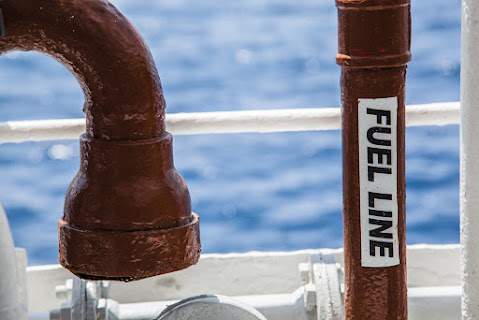Marine fuels: what is heavy fuel oil?
Fuel oils of viscosity similar to
tar fall under the heading of "heavy fuel oil" (HFO). HFO also
referred to as bunker fuel or residual fuel oil, is a by-product of the
distillation and cracking of petroleum. Because HFO is polluted with a variety
of substances, including aromatics, sulphur, and nitrogen, its
combustion-related emissions are more polluting than those of other fuel oils.
Due to its affordability when compared to more environmentally friendly fuel
sources like distillates, HFO is primarily employed as a fuel source for marine
vessel propulsion. The usage and transportation of HFO on board ships raise a
number of environmental issues, including the possibility of an oil leak and
the emission of hazardous substances and particles, such as black carbon.
HFO is made up of leftovers or
residue from petroleum sources after higher-quality hydrocarbons have been
recovered using techniques like thermal and catalytic cracking. As a result,
HFO is also sometimes called residual fuel oil. The fact that HFO is frequently
blended with cleaner fuels results in very varied chemical composition;
blending streams can contain carbon values ranging from C20 to greater than
C50. For a particular usage, HFOs are blended to create specific viscosity
and flow properties. Due to its diverse range of compositional qualities, HFO
is characterised by its processing, physical, and final usage properties.
The International Maritime
Organization's (IMO) International Code for Ships Operating in Polar Waters
currently forbids the use of HFOs as a fuel source for ships travelling in the
Antarctic (Polar Code). An HFO ban in Arctic waters is currently under
consideration for similar reasons.
Combustion and environmental
reactions:
Given the high sulphur content of HFO
(up to 5% by mass), the combustion reaction generates sulphur dioxide (SO2),
which eventually causes sulfuric acid (H2SO4) to develop in the atmosphere as
acid rain.
Acid rain creation example:
HOSO2 = OH + SO
HO2 + SO3 = HOSO2 + O2
SO3 + H2O H2SO4
Nitric acid (HNO3), a component of
acid rain, is formed as a result.
HNO3 + HNO2 = H2O + N2 + NO
HNO3 + 2 NO + H2O equals 3 HNO2.
4NO + 3 O2 + 2 H2O yields 4HNO3.
Due to its low cost compared to all other fuel oils, which are up to 30% less expensive, as well as the IMO's historically lax regulatory requirements for emissions of nitrogen oxides (NOx) and sulphur dioxide (SO2), HFO has been primarily used by the shipping industry since the middle of the 19th century. HFO is the most often utilised engine fuel oil on ships for these two reasons. The international marine sector used 200 million tonnes of fuel oil overall in 2007, of which 174 million tonnes were consumed as HFO, according to data that is currently available. There were 207.5 million tonnes of fuel oil sold with HFO in total, according to data accessible up through 2011 for the international marine shipping sector.
HFO use and transportation are
standard marine industry practices in the Arctic. More than 200 ships sailed
into Arctic waters in 2015, carrying 1.1 million tonnes of fuel, with HFO
accounting for 57% of the fuel used on these excursions. A huge increase from
the reported 400,000 tonnes in 2012, trends in HFO carriage were reported to
reach 830,000 tonnes in the same year. The entire fuel use of HFO by mass in
the Arctic was estimated in a 2017 report by the Norwegian Type Approval body
Det Norske Veritas (DNV GL), with larger boats being the biggest consumers.
HFO released into the environment
poses higher harm to flora and animals than distillate or other residual
fuels because of its extremely high viscosity and enhanced density. The Arctic
Council named the Arctic oil spill the worst hazard to the local marine
ecosystem in 2009. HFO, which is a byproduct of the distillation and cracking
operations, is distinct from other fuels in that it has higher overall toxicity.
Because of the freezing temperatures in the Arctic, which cause tar lumps to
form, and the emulsification process, it is viscous, preventing breakdown into
the environment. HFO has the potential to pollute the seafloor as well as the
water column due to its density, propensity to persist, and emulsification.




Comments
Post a Comment